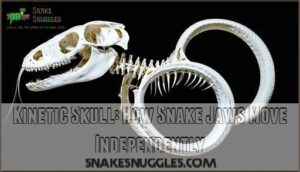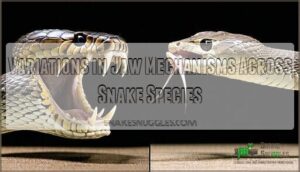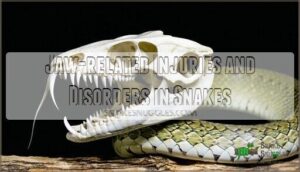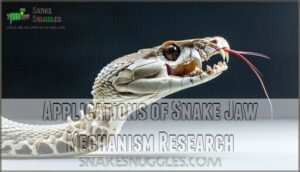This site is supported by our readers. We may earn a commission, at no cost to you, if you purchase through links.
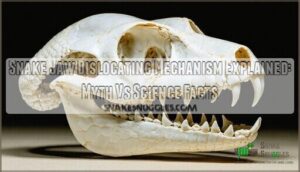
The snake jaw dislocating mechanism explained is actually much cooler than bone popping. Your snake’s jaw works like a stretchy biological hinge system.
The quadrate bone acts as a flexible pivot that swings nearly 180 degrees, while elastic ligaments stretch up to 150% without tearing. Think of it like a rubber band attached to moveable joints.
The lower jaw bones aren’t fused together like yours – they’re connected by stretchy tissue that lets them separate and move independently. This creates a mouth opening three times wider than the snake’s head, all through flexibility rather than dislocation.
The real magic happens when multiple skull bones coordinate like a synchronized dance.
Table Of Contents
- Key Takeaways
- Snake Jaw Anatomy: Unique Features and Adaptations
- Myth Vs. Reality: Do Snakes Actually Dislocate Jaws?
- Stretching The Limits: Snake Jaw Range of Motion
- Kinetic Skull: How Snake Jaws Move Independently
- Jaw Mechanics During Prey Ingestion
- Evolutionary Advantages of Snake Jaw Flexibility
- Variations in Jaw Mechanisms Across Snake Species
- Jaw-related Injuries and Disorders in Snakes
- Biomechanical Studies on Snake Jaw Movements
- Applications of Snake Jaw Mechanism Research
- Frequently Asked Questions (FAQs)
- Why do snakes put their jaws on the ground while moving?
- Why can snakes dislocate their jaws?
- How do snakes realign their jaws?
- Do anacondas unhinge their jaws?
- How do snakes dislocate their jaws?
- What is it called when a snake dislocates its jaw?
- How does a snake open its mouth so wide?
- How does snake tooth replacement affect jaw function?
- Can snakes chew or break down food?
- Do venomous snakes have different jaw mechanisms?
- Conclusion
Key Takeaways
- You’re witnessing flexibility, not dislocation – Your snake’s jaw uses elastic ligaments and a pivoting quadrate bone that stretches up to 150% without any bones actually separating or popping out of place.
- It’s a coordinated system of moving parts – The quadrate bone acts like a flexible hinge while unfused lower jaw bones move independently, creating a mouth opening three times wider than the snake’s head diameter.
- Multiple skull bones work together – Your snake’s entire skull features kinetic joints that allow different bone sections to move separately, creating a synchronized feeding mechanism that’s far more complex than simple dislocation.
- This gives snakes a massive evolutionary advantage – You’re looking at nature’s solution for consuming prey much larger than their heads, allowing snakes to access bigger meals and survive in diverse environments where rigid-jawed competitors can’t.
Snake Jaw Anatomy: Unique Features and Adaptations
When you look at a snake’s mouth, you’re witnessing one of nature’s most remarkable engineering feats.
Your snake’s jaw doesn’t actually dislocate like many people think—instead, it uses a complex system of flexible bones, stretchy ligaments, and moveable joints that work together like a biological hinge mechanism.
Quadrate Bone and Its Role
Through its unique quadrate bone mobility, you’ll discover how snakes achieve their incredible jaw suspension system.
This pivotal bone connects your snake’s lower jaw to skull via flexible ligament connections, enabling streptostyly evolution—the ability to swing jaws nearly 180 degrees wide.
Unlike rigid cranial kinesis in other reptiles, snake quadrate bone adaptations create feeding adaptations that let them consume prey without true snake jaw disarticulation.
Mandibular Symphysis Structure
Unlike fused bones in your jaw, the snake’s mandibular symphysis acts like nature’s ultimate stretchy hinge.
This flexible ligament connection lets jaw halves move independently, creating the gape correlation needed for massive meals.
- Symphysis flexibility enables independent mandible movement during feeding
- Ligament composition features elastic tissues instead of rigid bone fusion
- Evolutionary changes favored flexible connections over solid jaw structures
- Snake jaw disarticulation occurs through symphysis stretching, not dislocation
Elastic Ligaments and Connective Tissues
Snake jaw flexibility comes from three specialized elastic ligaments and connective tissues that work like nature’s rubber bands.
These tissues contain high concentrations of elastin fibers, allowing tissue elasticity up to 150% normal size without tearing.
Nature’s mouthguard, indeed!
Skull Kinesis in Snakes
While elastic ligaments provide flexibility, your snake’s entire skull works like a sophisticated puzzle.
Cranial kinesis means individual skull bones move independently through specialized joints. This skull flexibility creates jaw-skull coordination that’s perfectly synchronized.
Think of it as nature’s transformer – bones shift and rotate to maximize gape size. This kinetic skull evolution gives snakes their incredible feeding efficiency advantage over rigid-skulled predators.
Snakes’ saliva also plays a role, lubricating large prey for easier swallowing.
Myth Vs. Reality: Do Snakes Actually Dislocate Jaws?
You’ve probably heard the dramatic claim that snakes dislocate their jaws to swallow massive prey, but this popular belief couldn’t be further from the truth.
Snake jaws stretch impossibly wide without breaking a single bone—nature’s ultimate magic trick revealed
The reality behind snake feeding mechanics is far more fascinating than simple bone dislocation—it’s a complex symphony of flexible joints, elastic ligaments, and specialized anatomy that allows these remarkable predators to consume meals larger than their own heads.
Without breaking a single bone, snakes can achieve this feat, making their feeding mechanism a remarkable example of evolutionary adaptation, driven by the need to eat massive prey.
Common Misconceptions About Snake Jaw Dislocation
You’ve likely heard three major snake myths that paint these reptiles as jaw-dislocating acrobats. The truth? Snake jaw dislocation is pure fiction—their incredible jaw flexibility comes from specialized anatomy, not bone separation.
| Common Myth | What People Think | Reality Check |
|---|---|---|
| Jaw "unhinging" | Bones pop out of place | Cranial kinesis allows controlled movement |
| Partner revenge | Snakes seek vengeance | No social bonds exist |
| Living heads | Decapitated heads stay alive | Immediate death occurs |
These snake myths persist because feeding mechanics look impossible. When you see a python swallowing prey twice its head size, it’s easy to assume dislocation facts involve actual bone separation.
But anatomy debunked reveals elastic ligaments and mobile joints create this snake jaw flexibility without snake jaw disarticulation.
The jaw dislocation myth stems from misunderstanding how snake jaw disarticulation actually works—spoiler alert: it doesn’t!
Scientific Explanation of Jaw Flexibility
Here’s the truth that’ll surprise you: snakes don’t actually dislocate their jaws to swallow prey! Instead, their snake jaw dislocating mechanism relies on remarkable flexibility.
The quadrate bone acts like a flexible hinge, connecting skull to jaw with incredible Quadrate Mobility. Ligament Elasticity allows dramatic stretching without damage.
| Anatomical Feature | Function |
|---|---|
| Separate mandibles | Mandible Independence for walking motion |
| Elastic ligaments | Enable 150% jaw expansion |
| Quadrate bone pivot | Permits wide gape angles |
| Kinetic skull joints | Skull Kineticism during feeding |
This Gape Mechanics system keeps bones connected while maximizing mouth opening.
Comparison With Other Reptile Jaw Mechanisms
Unlike snakes’ jaw flexibility, other reptiles take different approaches to feeding challenges.
Crocodile bite force crushes prey with bone-fusing power, while turtle jaw mechanics rely on sharp beaks. Lizard feeding systems vary dramatically across species.
| Reptile Type | Jaw Mechanism |
|---|---|
| Snakes | Flexible quadrate bone, cranial kinesis |
| Crocodiles | Rigid skull, massive bite force |
| Turtles | Beak-like jaws, no teeth |
| Lizards | Variable flexibility, some kinetic skulls |
Snake skull anatomy stands apart with its snake jaw dislocating mechanism – though it’s really just extreme flexibility, not actual dislocation.
Stretching The Limits: Snake Jaw Range of Motion
You’ll be amazed to learn that different snake species can open their mouths to wildly different angles – some achieving nearly 180 degrees while others max out around 130 degrees.
The secret lies in a perfect storm of factors: your snake’s size, muscle strength, prey preferences, and even its evolutionary history all work together to determine just how wide those jaws can stretch, influenced by the snake’s muscle strength.
Maximal Gape Angle in Various Snake Species
You’ve learned snakes don’t actually dislocate their jaws – now let’s examine their impressive maximal gape angle capabilities.
Burmese pythons can stretch their mouths four times wider than their skull diameter, achieving gape angles exceeding 100 degrees.
Brown treesnakes show smaller gape areas despite similar length, while aquatic species like Natrix tessellata reach 75-degree angles during strikes.
These gape angle variations directly influence prey size limits and snake feeding strategies across different species.
The study of skull morphology provides valuable insights into the adaptations of snakes for efficient prey capture and consumption.
Factors Influencing Jaw Flexibility
Snake jaw flexibility factors work like a biological recipe. Species variation determines the baseline – pythons open wider than vipers due to different feeding habits.
Prey size preferences shape development; snakes targeting large meals develop stronger jaw muscle groups.
Elastic tendons and elastic ligaments provide the stretchy foundation, while cranial kinesis allows independent bone movement.
Together, these jaw flexibility factors create each species’ unique snake skull flexibility profile.
The unique characteristics of each species are also influenced by their snake anatomy features that aid in their survival and hunting strategies.
Muscular Control of Jaw Movements
The complex motor control system behind snake jaw flexibility operates like a precision orchestra.
Specialized jaw muscles containing both slow-twitch and fast-twitch muscle fibers receive commands through intricate neural pathways.
These muscular contractions enable independent jaw movement through the intramandibular joint while cranial kinesis allows skull bones to shift.
This remarkable coordination lets snakes stretch their mouths nearly 150% wider than normal size.
Kinetic Skull: How Snake Jaws Move Independently
You’re about to discover how a snake’s skull works like a complex machine with moving parts that operate independently.
Unlike your rigid jaw, a snake’s kinetic skull features multiple joints that allow different bone sections to move separately, creating the incredible flexibility needed to swallow prey much larger than their head, which is a result of its complex machine-like operation.
Streptostyly and Its Importance
When you observe snake jaw range of motion, you’re witnessing streptostyly in action.
This jaw flexibility mechanism lets the quadrate bone rotate independently, creating extraordinary skull movement.
The mobile quadrate reduces stress during feeding while maximizing gape angle.
Streptostyly mechanics enable snakes to:
- Open their mouths wider than their body diameter
- Rotate jaw bones without snake jaw dislocation
- Coordinate complex feeding movements
- Handle prey much larger than their heads
- Distribute bite forces evenly across the skull
This kinetic bones system works alongside other snake cranial kinesis features, setting up the foundation for independent jaws operation.
Intramandibular Joint Function
Understanding streptostyly sets the stage for exploring another remarkable feature: the intramandibular joint. This flexible connection between jaw halves acts like nature’s ultimate hinge system.
Each mandible operates independently, dramatically increasing gape size during feeding.
| Feature | Function | Benefit |
|---|---|---|
| Joint Mobility | Independent jaw movement | Maximizes mouth opening |
| Bone Structure | Flexible ligament connection | Prevents jaw dislocation |
| Muscle Control | Coordinated jaw flexion | Precise prey manipulation |
| Kinetic Movement | Alternating jaw advancement | Efficient swallowing process |
This intramandibular joint transforms snake mandible movement into a sophisticated feeding mechanism, enabling cranial kinesis without actual jaw dislocation—just incredible snake jaw flexibility through evolutionary engineering.
Cranial Kinesis in Snake Feeding
Unlike human skulls with rigid connections, a snake’s cranial kinesis creates a flexible framework for extraordinary feeding mechanics.
This cranial adaptation evolved through millions of years of snake evolution, allowing remarkable jaw flexion and skull movement.
Here’s how this snake feeding mechanism works:
- Multiple skull bones pivot independently during prey capture
- Upper jaw segments separate laterally for enhanced gape
- Kinetic joints coordinate seamlessly without snake jaw dislocation
This jaw flexibility lets snakes consume prey substantially larger than their heads.
Jaw Mechanics During Prey Ingestion
When you watch a snake swallow prey twice its head size, you’re seeing one of nature’s most impressive feeding mechanisms in action.
Nature’s ultimate dining hack: no dislocated bones, just pure biomechanical genius
Nature’s most incredible stretching act happens right before your eyes.
The process involves a precise sequence of jaw movements, specialized teeth, and powerful muscle contractions that work together like a biological conveyor belt.
Step-by-step Process of Swallowing Large Prey
You’re watching nature’s most impressive swallowing process unfold.
The snake positions its gape angle wide over prey, then begins jaw movement like a ratcheting mechanism.
Left and right jaws alternate forward, effectively "walking" over the meal.
This feeding mechanics isn’t snake jaw dislocation – it’s pure jaw flexibility.
Each muscular contraction pulls prey deeper into the throat.
The snake feeding mechanism transforms prey capture into efficient prey ingestion through coordinated snake swallowing adaptations.
Role of Recurved Teeth in Prey Manipulation
Nature’s fishing hooks don’t let go easily.
Your snake’s recurved teeth curve backward like tiny anchors, gripping prey during jaw movement. These specialized hooks prevent escape while allowing forward progress through the throat.
Here’s how tooth structure enables successful prey capture:
- Backward curve design – Teeth angle toward the throat, creating one-way travel for prey
- Sharp points – Penetrate skin and scales for secure grip during feeding behavior
- Multiple rows – Upper and lower jaws contain several tooth rows for redundant holding power
- Flexible attachment – Teeth pivot slightly to maintain contact during jaw adaptations
- Size variation – Larger teeth at jaw corners provide extra grip for snake prey ingestion
This tooth function transforms feeding ecology into a no-escape scenario for captured meals.
Muscular Contractions During Feeding
When you watch a snake devour prey twice its head size, coordinated muscular contractions drive the entire swallowing process.
The jaw movement relies on precise muscle fiber coordination—slow-twitch fibers provide sustained force while fast-twitch enable quick adjustments. This muscular control creates the snake feeding mechanism’s efficiency.
- Intermandibular muscles stretch up to 770% of resting length
- Jaw muscles alternate contractions for independent jaw movement
- Esophageal muscles create peristaltic waves pushing food downward
- Spinal muscles produce undulations moving prey deeper internally
This jaw flexibility proves there’s no snake jaw dislocation—just remarkable feeding mechanics and prey capture adaptation. The unique snake digestive system adaptations, including flexible digestive mechanisms, allow for efficient consumption of large prey, demonstrating coordinated muscular contractions and precise muscle fiber coordination in action, which is a result of remarkable feeding mechanics.
Evolutionary Advantages of Snake Jaw Flexibility
You’ll discover that snake jaw flexibility isn’t just a neat trick—it’s a game-changing evolutionary advantage that helped snakes become incredibly successful predators.
This remarkable adaptation allows them to tackle prey much larger than their heads, giving them access to bigger meals and better survival odds than their rigid-jawed competitors, which is a significant evolutionary advantage.
Adaptation to Diverse Prey Sizes
Snakes have cracked the code for Prey Size Variation through incredible Jaw Flexibility.
You’ll find them munching everything from insects to animals larger than their heads! This Adaptive Mechanism isn’t just about opening wide—it’s smart engineering.
Their Feeding Strategies let them grab whatever’s available, whether it’s a slim lizard or chunky rodent. No Dietary Specialization means no missed meals, giving them serious survival advantages across different habitats.
Competitive Edge in Predator-prey Relationships
Flexibility transforms snakes into formidable hunters with unmatched Adaptive Advantage in predator-prey relationships.
This remarkable jaw system enables Hunting Strategies that outcompete rigid-jawed rivals.
Here’s how jaw flexibility creates Survival Mechanics:
- Prey Defense bypass – swallows struggling victims before escape
- Predator Tactics expansion – tackles diverse prey sizes others can’t handle
- Snake feeding ecology dominance – occupies multiple ecological niches simultaneously
- Prey ingestion speed – reduces exposure time during vulnerable feeding
- Snake predatory ecology versatility – adapts hunting methods based on available prey
Energy Efficiency in Feeding
You’ll discover that flexible jaw mechanics work like a biological cost-cutting system.
These feeding strategies don’t waste precious energy reserves. When you observe snake jaw dislocation mechanism in action, you’re watching energy conservation at its finest.
Their specialized jaw mechanics create remarkable digestion efficiency:
- Reduced muscle strain during swallowing motions
- Faster breakdown of oversized meals
- Lower metabolic costs throughout the feeding process
This prey capture system lets snakes tackle meals worth weeks of hunting with minimal effort.
Variations in Jaw Mechanisms Across Snake Species
You’ll find that different snake species have evolved remarkably diverse jaw mechanisms that match their unique hunting styles and environments.
From the extra-wide gape of constrictors to the lightning-fast strike adaptations of venomous species, each group has fine-tuned their jaw flexibility to become the ultimate predator in their niche.
Differences Between Constrictors and Venomous Snakes
Among predators, constrictors and venomous snakes showcase dramatically different Hunting Styles.
Constrictors possess wider, more robust jaws supporting extreme gape angles—perfect for their Prey Preference of large meals after powerful squeezing.
Venomous snakes feature narrower skulls optimized for lightning-fast Venom Delivery through specialized fangs.
Think heavyweight wrestler versus precision surgeon!
Their snake jaw mechanism reflects distinct Constrictor Behavior: brute-force consumption versus surgical strikes, each perfectly adapted to their Snake Habitat demands.
Specialized Adaptations in Burrowing Snakes
Many underground dwellers have developed snake jaw adaptations that revolutionize Burrowing Techniques and Soil Navigation.
Their reinforced skulls resist crushing forces while specialized jaw flexibility allows efficient Subterranean Hunting.
These snake biomechanics create perfect Tunnel Architecture for Underground Shelter.
Unlike snake jaw dislocation myths, their snake skull evolution features rigid joints optimized for digging rather than gaping wide.
Aquatic Snake Jaw Modifications
While burrowing snakes master underground hunting, aquatic species face different challenges in water environments.
You’ll find that snake jaw adaptations in aquatic habitats focus on Hydrodynamic Feeding efficiency. These water-dwelling serpents can’t rely on typical snake jaw dislocation mechanisms due to Snake Buoyancy issues.
Aquatic Adaptations include:
- Streamlined Jaw Morphology reduces water resistance during strikes
- Modified skull bones enhance snake biomechanics for underwater prey capture
- Specialized muscle arrangements maintain jaw flexibility despite water pressure
- Enhanced sensory systems compensate for reduced vision underwater
- Snake skull evolution favored faster jaw closure to prevent Water Prey escape
Jaw-related Injuries and Disorders in Snakes
While snakes possess remarkable jaw flexibility that seems almost impossible, their amazing anatomy can sometimes work against them.
You’ll be surprised to learn that these incredible feeding machines can actually suffer from jaw injuries and disorders that require careful attention and treatment, which highlights their amazing anatomy.
Common Jaw Alignment Issues
Just like humans, snakes experience jaw misalignment from trauma, infections, or birth defects.
These orthodontic problems create bite issues and facial asymmetry. You’ll notice uneven jaw movements, eating difficulties, or visible deformities.
Tooth crowding can worsen alignment problems. Unlike the myth of snake jaw dislocation, these are real medical conditions affecting jaw flexibility.
Watch for signs during feeding – misaligned jaws struggle with normal prey consumption. Early detection prevents complications.
Treatment and Management of Jaw Injuries
Spotting jaw alignment issues early helps you act fast when your snake needs help. Quick diagnosis saves time and prevents complications.
Veterinarians use radiographs and CT scans to confirm fractures or dislocations. Under anesthesia, they’ll gently manipulate the jaw back into place.
Here’s what treatment involves:
- Manual realignment under anesthesia for simple dislocations
- Surgical repair with sutures or splints for complex fractures
- Pain management with medications like meloxicam during recovery
- Tube feeding when normal swallowing becomes impossible
Recovery takes 4-8 weeks with proper care and monitoring.
Prevention of Jaw-related Problems in Captivity
While treatment helps injured snakes recover, prevention beats cure every time.
Smart Captive Care starts with proper Habitat Design – spacious enclosures with hiding spots reduce stress-related Jaw Injury.
Use gentle Feeding Techniques like offering pre-killed prey to prevent feeding aggression. Maintain consistent Snake Nutrition schedules and avoid handling during digestion.
Regular vet checkups catch problems early, keeping your snake’s jaw health maintenance on track for years ahead.
Properly designed snake enclosure systems are essential for reducing jaw-related problems in captivity.
Biomechanical Studies on Snake Jaw Movements
You can’t fully understand snake jaw mechanics without studying them in action.
Modern biomechanical research uses high-tech tools like X-ray cinematography, 3D computer models, and force sensors to reveal exactly how these flexible jaws work during feeding, which is crucial for understanding the mechanics of snake jaws, and biomechanical research is key to this understanding.
X-ray Cinematography Findings
X-ray cinematography captures jaw movement in real-time, revealing how snake anatomy works during feeding.
You can watch the quadrate bone pivot and see skull flexibility in action. These films show feeding mechanics without snake jaw dislocation myths.
The intramandibular joint moves independently while bone structure stays connected. Cinematography analysis proves jaw flexibility comes from elastic ligaments, not dislocated bones.
It’s like watching nature’s engineering masterpiece unfold frame by frame.
Understanding snake jaw injuries is essential for providing proper care and recognizing signs of a broken jaw, such as those described in cases of broken jaw treatment.
3D Modeling of Snake Jaw Mechanics
Scientists use 3D Visualization and Jaw Simulation to map snake jaw mechanics with incredible precision.
These digital models reveal how the quadrate bone and intramandibular joint work together during feeding.
Biomechanics Analysis shows Mechanical Advantage calculations that explain how snakes achieve massive gape angles.
Snake Kinematics data helps researchers understand snake jaw structure without the jaw dislocation myth.
Force Analysis During Prey Capture and Ingestion
When you watch a snake capture prey, you’re witnessing incredible jaw forces in action.
Researchers measure bite strength during feeding mechanics, revealing how jaw flexibility enables powerful prey ingestion.
The snake feeding mechanism generates surprising pressure—some species exert over 200 pounds per square inch.
Swallowing dynamics show that larger prey requires exponentially more force, proving snake jaw movement isn’t about jaw dislocation but precise biomechanical engineering.
Applications of Snake Jaw Mechanism Research
You’ll be amazed to discover that studying snake jaw mechanics isn’t just academic curiosity—it’s actually revolutionizing fields from robotics to medicine.
Scientists are using these flexible jaw secrets to design better surgical tools, create more adaptable robots, and even help save endangered snake species through improved understanding of their feeding needs, which is actually helping.
Bioinspired Robotics and Flexible Designs
You’ll find snake jaw flexibility revolutionizing Robot Arm Design and Adaptive Mechanisms everywhere now.
Engineers copy snake anatomy to create Soft Robotics with Flexible Materials that bend like flexible ligaments.
These bioinspired robotics systems use Kinetic Systems mimicking jaw mechanics for grippers that handle fragile items.
From surgical tools to warehouse robots, snake-inspired designs solve problems traditional rigid systems can’t touch.
The development of Soft Robotics systems relies on understanding advanced soft robotics to improve robotic flexibility and functionality.
Medical Implications for Human Jaw Disorders
Beyond robotics lies even more exciting territory—your health. Snake jaw research is revolutionizing how doctors treat human jaw disorders, turning what seemed impossible into reality.
Here’s how this research transforms medical care:
- Jaw Surgery techniques now use snake-inspired flexible fixation devices that double repair strength
- Temporomandibular Therapy incorporates jaw-opening exercises mimicking snake stretch mechanics to reduce TMJ pain
- Facial Reconstruction benefits from biomimetic approaches using snake quadrate bone mobility concepts
- Dental Implants designed with snake jaw flexibility principles improve long-term success rates
The study of snake teeth structure has also led to a deeper understanding of jaw mechanics and their applications in medical treatments. The jaw dislocation myth finally meets jaw flexibility science in operating rooms worldwide.
Conservation Efforts for Endangered Snake Species
Habitat Preservation efforts depend heavily on understanding snake feeding behavior.
When you know how snake species use their jaw mechanisms, you can better protect their hunting grounds.
Species Monitoring programs track jaw-related injuries in wild populations, revealing environmental stressors.
Conservation Policies now consider feeding requirements when establishing Snake Refuge areas.
Wildlife Protection agencies use jaw research to improve captive breeding success rates.
This snake research applications approach helps endangered species recovery by ensuring adequate prey availability and proper habitat design for snake conservation programs.
Frequently Asked Questions (FAQs)
Why do snakes put their jaws on the ground while moving?
Snakes don’t deliberately put their jaws on the ground.
You’re observing their natural ground-level movement pattern, where their head stays close to surfaces for navigation, scent detection, and efficient locomotion through varied terrain, utilizing efficient locomotion.
Why can snakes dislocate their jaws?
Actually, you can’t dislocate your jaw because snakes don’t either.
They’ve got flexible ligaments and a unique quadrate bone system that lets their mouth stretch incredibly wide without any bones coming apart.
How do snakes realign their jaws?
Unlike a broken zipper that needs forcing back into place, you don’t need to help snakes realign their jaws after feeding.
Their elastic ligaments and flexible quadrate bones naturally return to normal position automatically.
Do anacondas unhinge their jaws?
No, anacondas don’t unhinge their jaws. They’ve got flexible ligaments and a quadrate bone that lets their mouths stretch incredibly wide—up to 180 degrees—without any dislocation happening.
How do snakes dislocate their jaws?
Here’s the myth-busting truth: you won’t see snakes actually dislocating their jaws.
Instead, they’ve got flexible ligaments and a unique quadrate bone that lets their jaws stretch wide without any bones popping out of place, which is a key aspect of their unique anatomy.
What is it called when a snake dislocates its jaw?
Snakes don’t actually dislocate their jaws—that’s a common myth. They use "gaping," where flexible ligaments and unfused mandibles allow their mouths to stretch incredibly wide without any bones separating.
How does a snake open its mouth so wide?
You’d be amazed how nature’s engineering beats even the best hinges—your snake’s mouth opens wide through flexible ligaments, not dislocation.
The quadrate bone pivots while elastic connective tissues stretch, letting independent jaw halves "walk" over prey, which is a remarkable example of nature’s engineering.
How does snake tooth replacement affect jaw function?
Your snake’s teeth continuously replace themselves throughout life, with new ones growing behind worn or lost teeth.
This polyphrodont system guarantees you’ll always have sharp, functional teeth for gripping prey without affecting jaw flexibility or feeding mechanics, ensuring your snake maintains sharp teeth.
Can snakes chew or break down food?
Picture a python trying to munch a cracker—it won’t work.
You can’t chew without molars, and snakes lack grinding teeth entirely.
They’re built for swallowing prey whole, using backward-curved fangs only for gripping, not breaking down food, which is why they can’t munch a cracker.
Do venomous snakes have different jaw mechanisms?
Venomous snakes don’t have fundamentally different jaw mechanisms from non-venomous species. You’ll find they use the same flexible quadrate bone system and elastic ligaments for swallowing large prey whole.
Conclusion
Understanding the snake jaw dislocating mechanism explained reveals nature’s brilliant engineering solution.
Your snake doesn’t actually dislocate anything – it’s using advanced biological hinges and stretchy ligaments that work better than any human-made device.
The quadrate bone pivots nearly 180 degrees while elastic tissues stretch up to 150% without damage.
This flexible system lets snakes swallow prey three times their head width through coordination, not dislocation.
It’s proof that evolution creates solutions we’re still trying to copy, showcasing the remarkable ability of snakes to adapt and thrive in their environments, a true testament to nature’s brilliant design.
- https://www.nhm.ac.uk/discover/snakes-senses-stretchy-jaws-deadly-venom.html
- https://en.wikipedia.org/wiki/Snake_skeleton
- https://snakesarelong.blogspot.com/2018/02/basics-of-snake-skulls.html
- https://thehsi.org/2015/05/06/biting-off-more-than-they-can-chew-how-snakes-swallow-large-prey/
- https://www.livescience.com/32096-how-do-snakes-swallow-large-animals.html









